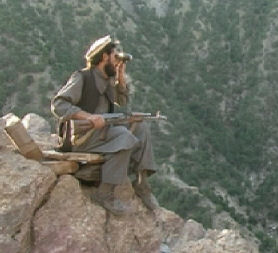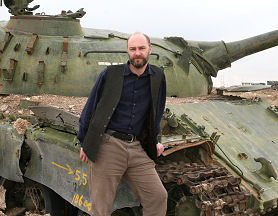Afghan Taliban: greatest guerrilla insurgency?
By Channel 4 News
 |
August 16, 2010 As the war in Afghanistan continues nine years on, author James Fergusson analyses the success of the Taliban and asks how the insurgency has managed to endure the world's mightiest armies.  Before the British Army deployed to Helmand in southern Afghanistan in the summer of 2006, it was confidently asserted by military intelligence that there were "no more than a thousand" Taliban insurgents in the entire province. The assumption was that they would be no match for the 3,300-strong task force originally sent to challenge them. Before the British Army deployed to Helmand in southern Afghanistan in the summer of 2006, it was confidently asserted by military intelligence that there were "no more than a thousand" Taliban insurgents in the entire province. The assumption was that they would be no match for the 3,300-strong task force originally sent to challenge them.If the military analysts had been right, the province should certainly have been purged of violence by now. Nato forces have killed far more than a thousand Taliban in Helmand province since 2006. And yet the insurgency continues to deepen. The number of IEDs (improvised explosive device) laid in the last year alone has trebled. British troops, of whom 300 will soon have been killed as a result of hostile action, are now dying at twice the rate of a few months ago - in total 331 British soldiers have lost their lives in the country. Deaths are at a rate on a par with Soviet losses in the 1980s. Enemy underestimated For a fifth consecutive summer, Nato is struggling to clear insurgents from urban communities barely 15 miles from the provincial capital, Lashkar Gah. How did military intelligence underestimate the Taliban so badly? And how has a rag-tag group of lightly armed fighters, whatever their true number, managed to resist the world's mightiest armies for so long? There is no single reason for the Taliban's success. Religious and cultural convictions, the Pashtuns' warlike nature and their historical antipathy to foreigners, and the advantage of an untouchable rear-operating base in Pakistan have all played their role. But the root cause of the insurgency's endurance is that the west misunderstood the nature of the enemy in Afghanistan from the start. The Taliban regime of 1996 to 2001 came to be seen in the west as the evil epitome of Islamic fundamentalism: repressive, undemocratic and backward. In the minds of western policy makers, therefore, it followed that ordinary Afghans would welcome the military intervention of 2001 that deposed Mullah Omar's government. And so they did, to begin with. |
Afghanistan's choice
There was, however, another side to the Taliban that westerners tend to forget. For all their faults, the movement brought the majority of Afghans a degree of peace that they hadn't known since the 1970s.
The five-year civil war that followed the Soviet retreat in 1989 was a particular catastrophe. In the first six months of 1994, some 25,000 civilians were slaughtered in Kabul alone. The Taliban emerged that year with the specific agenda of restoring law and order to the country, and against all the odds they succeeded. To many Afghans, domination by a coterie of Pashtun mullahs, for all their harshness, was easily preferable to the preceding horror.
Afghans today are presented with a different choice – continued rule by a western-backed kleptocracy in Kabul, or a return to the Taliban system of the 1990s – and to many war-weary Afghans, the latter once again appear to be the lesser of two evils.
The presence of tens of thousands of infidel troops who support Kabul has brought little visible improvement in the economic welfare of the country; and despite Nato's new rules of engagement, civilians continue to die in their thousands as a direct or indirect result of the war with the Taliban: over 2,400 of them in 2009 alone, according to the UN.
SupportIn the Nad e Ali district in Helmand, scene of the latest Nato clearance operation, residents interviewed by one British journalist were unanimous in their support for the Taliban, and in their desire for a negotiated settlement with them. "You cannot bring peace by fighting – war is not the answer," said motorcycle mechanic Sultan Mohammed.
There is support for political compromise away from the warzone, too – even, unexpectedly, among some women in Kabul. "I changed my view [of the Taliban] three years ago when I realised Afghanistan is on its own," said Shukria Barakzai recently - a Pashtun MP and one of the country’s leading women’s rights campaigners.
"It’s not that the international community doesn't support us. They just don't understand us. The Taliban are part of our population. They have different ideas, but as democrats we have to accept that."
Her view is all the more remarkable considering that in 1999 when the Taliban were still in power, Barakzai was beaten by their religious police, the infamous Department for the Propagation of Virtue and the Prevention of Vice, for the "crime" of going to the doctor’s unaccompanied by her husband.
Resistance to interference from outsiders is almost hard-wired into the psyche of the Pashtuns, whose tribal society has survived almost 3,000 years of foreign invasion and occupation by Persians, Macedonians, Arabs and Mongols. "Then you British came, 150 years ago," said Ustad Rafeh, a Professor of Pashtun history at Kabul university.
"You had 60,000 troops and the best artillery, but it was Pashtuns who surrounded Kabul and killed 17,000 of you as you tried to escape. The rulers of your Empire thought this was an accident: they couldn't accept such a defeat, so they attacked again, in 1880. We killed 12,000 of you that time, at Maiwand. The same with the Soviets in 1979: most of their original army was destroyed. What makes you think that it will be any different for America this time?"
 Taliban fighters featured in a film by journalist Paul Refsdal.
Taliban fighters featured in a film by journalist Paul Refsdal. Skilful fighters
The present generation of Taliban leaders are as tough and skilful at fighting as any that preceded them. The mullahs were members of the famous mujahideen before they reconstituted themselves as what is now known as the Taliban in 1994, and were hardened by a decade of war against the Soviets.
One mullah specialised in ambushing armoured vehicles by hiding under water in a ditch by the road, breathing from the inner tube of a bicycle tyre. They could and frequently did survive on a handful of dates when supplies ran low, and they faced Afghanistan's extremes of heat and cold in the same old sandals and shalwar qamiz each day. When Mullah Omar lost an eye to a splinter from a bomb dropped by a Russian MiG in 1988, he bandaged up the wound himself before carrying on.
It is one of the grimmest ironies of the present conflict that it was in large part CIA dollars that armed and trained them in guerrilla tactics, usually in special ISI-run camps over the Pakistan border. The US supplied the mujahideen with shoulder-held Stinger missiles – and the training to operate them – that enabled them to shoot down the Soviets' Hind transport helicopters, a development credited with turning the tide of that war. Today, the greatest fear of Nato commanders is that the same fighters will bring down their Chinooks.
Religious duty
To many Taliban, the mere presence of infidel troops on Afghanistan's holy soil is justification enough for resistance. The ejection of Nato is not just the movement's primary political goal: it is also, as they see it, a religious duty.
 "We are against war," as a Taliban commander once explained to me. "It creates nothing but widows and destruction. But jihad is different. It is our moral obligation to resist you foreigners. One year, a hundred years, a million years, ten million years – it is not important. We will never stop fighting. At Judgement Day, Allah will not ask, "What did you do for your country?" He will ask, "Did you fight for your religion?""
"We are against war," as a Taliban commander once explained to me. "It creates nothing but widows and destruction. But jihad is different. It is our moral obligation to resist you foreigners. One year, a hundred years, a million years, ten million years – it is not important. We will never stop fighting. At Judgement Day, Allah will not ask, "What did you do for your country?" He will ask, "Did you fight for your religion?""The Taliban's second goal, once Nato has left, is the "sharia-isation" of the constitution – a document that was ratified in 2003, and which they regard as a foreign imposition and "not in Afghanistan's interests," as one senior ex-Taliban leader explained to me.
He may have a point. The constitution that emerged from the Bonn peace process was indeed drawn up with the help of several western technical experts. The Taliban, furthermore, were not invited to contribute, an omission that Lakhdar Brahimi, the senior UN envoy who helped organise the original Bonn meeting, described as "our original sin".
Pashtuns have historically always ruled Afghanistan, and their sense that their country has been "stolen" from them by foreigners in alliance with the non-Pashtun minorities provides another powerful motivation to resist.
Historical sympathies Finally, there is the question of Pakistan. All insurgencies need a rear operating base in which to rest, recuperate and reorganise; a relatively safe zone in which to re-arm as well as to recruit fresh fighters for the cause.
Pakistan could hardly be more perfect. The Taliban is primarily a Pashtun movement and the majority of Pashtuns – 25 million out of a total 42 million – call Pakistan their home, making it a natural source of sympathy for insurgency. And because the mountainous, 1,600-mile border between the countries is physically impossible to close, it is also impossible to prevent arms and recruits from replenishing those that Nato kills or destroys.
 Perhaps half a million mujahideen died in the war against the Soviets, along with about a million civilians: numbers that the modern Taliban insurgency has hardly begun to match. The Red Army, for its part, suffered more than 14,000 killed and nearly 54,000 wounded. Given their history, the Taliban seem highly unlikely to stop fighting until their demands are at least partly met.
Perhaps half a million mujahideen died in the war against the Soviets, along with about a million civilians: numbers that the modern Taliban insurgency has hardly begun to match. The Red Army, for its part, suffered more than 14,000 killed and nearly 54,000 wounded. Given their history, the Taliban seem highly unlikely to stop fighting until their demands are at least partly met.No wonder western leaders on both sides of the Atlantic are now openly discussing military withdrawal, and the possibility of a negotiated settlement.
James Fergusson's Taliban – The True Story of the World's Most Feared Guerrilla Fighters, is published on 19 August by Bantam Press.


No comments:
Post a Comment